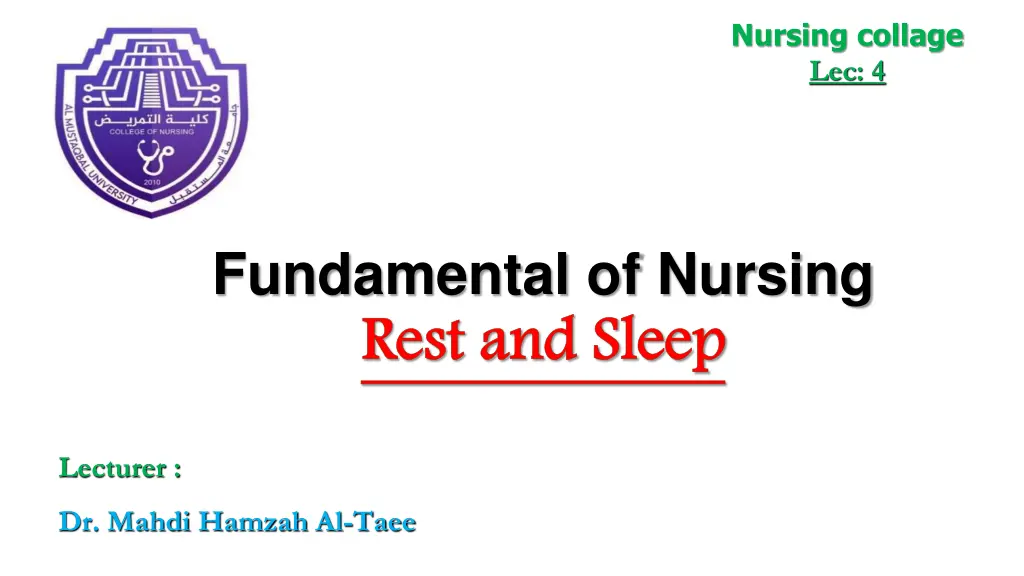
Understanding the Physiology and Importance of Sleep in Nursing Education
Explore the fundamental concepts of sleep and its impact on health in nursing education. Learn about the stages of sleep, factors affecting sleep quality, and the role of rest in maintaining overall well-being.
Download Presentation

Please find below an Image/Link to download the presentation.
The content on the website is provided AS IS for your information and personal use only. It may not be sold, licensed, or shared on other websites without obtaining consent from the author. If you encounter any issues during the download, it is possible that the publisher has removed the file from their server.
You are allowed to download the files provided on this website for personal or commercial use, subject to the condition that they are used lawfully. All files are the property of their respective owners.
The content on the website is provided AS IS for your information and personal use only. It may not be sold, licensed, or shared on other websites without obtaining consent from the author.
E N D
Presentation Transcript
Nursing collage Lec: 4 Fundamental of Nursing Rest and Sleep Rest and Sleep Lecturer : Dr. Mahdi Hamzah Al-Taee
Definition of Sleep: A state of rest accompanied by altered of consciousness and relative in activity. Physiology of sleep: two system in the brain responsible about the sleep 1.Reticular activating system. 2.Circadian rhythm: (rhythmic biological clock) regularly begins at third week of life.
Functions of sleep (importance of sleep): 1.Maintain metabolic- caloric balance. 2.Necessary for memory. 3.Necessary for learning. 4.Thermal equilibrium. 5.Immune competence. Sleep phases: There are two kinds of sleep 1.Rapid eye movement sleep. 2.Non rapid eye movement sleep or (slow wave sleep).
Rapid eye movement (REM sleep). Characteristics: a)Compromise 20- 25% of night sleep time. b)Dreaming common. c)Vital signs increase. d)Metabolic rate increase. e)Depress of skeletal muscle tone.
Non Rapid Eye Movement (NREM). Constitutes of 70% of total sleep, include four stages: Stage I: 1.Constitutes 5% of total sleep. 2.Person is in transitional stage between wakefulness and sleep. 3.Person is in a relaxed state but still aware of surrounding. 4.Person can be aroused easily. Stage II: 1)Person falls into a stage of sleep. 2)Person can be aroused with relative ease. 3)This stage constitutes 50% to 55% of sleep.
Stage III 1)The depth of sleep increases, and arousal becomes increasingly difficult. 2)This stage composes about 10% of sleep. Stage IV 1.The person reaches the greatest depth of sleep, which is called delta sleep. 2.Arousal from sleep is difficult. 3.Physiologic changes in the body include the following: Temperature, Pulse, respiratory and Blood pressure decreases. Muscles are relaxed. 4.Constitutes about 10% of sleep.
Factors affecting sleep 1.Illnesses: pain or dyspnea lead to disturbed sleep. 2.Environment: when environment around people changed (In a hospital, bedroom change or changed in light and other factors such as noisy environment, these lead to decrease sleep. 3. Fatigue: 4. Medications: drugs that decrease REM sleep include (barbiturate, amphetamines, and antidepressant diuretics caffeine, antihypertensive, steroids, and asthma medication. 5. Psychological stress: depression, anxiety and tension. 6. Life style and habits: Some habits help in sleeping such as bathing praying, reading and milk drink. 7. Nutrition and metabolism: some people have difficulty sleeping after heavy meal but some people have disturbed sleep if hungry. 8. Elimination patterns: the need to void is one of the most frequent internal stimuli to disturbed sleep among the population. 9. Alcohol intake: 10. Motivation: 11. Caffeine containing beverages.
Common sleep disorders The most recent classification of sleep disorders include: 1.Dyssomnias. 2.Parasomnia. 3.Sleep disorders associated with medical or psychological disorders 1.Dyssomnia include: 1. Insomnia: difficult falling to sleep, intermittent sleep, or early awakening from sleep.
Causes of insomnia: 1. Psychological (a tension, stress and depression) 2.Physiological insomnia (pain, age, alcohol intake, caffeine, medication). 2.Hypersomnia: is a condition characterized by excessive sleep during the day. 3.Narcolepsy: is a chronic neurological disorder caused by the brain inability to regulate sleep- wake cycles normally in which there is a sudden loss of voluntary muscle tone. 4.Sleep Apnea: is a condition of absence of breathing during sleep.
Obstructive sleep apnea occurs when the airway is occluded due to collapse of the hypopharynx. Normally the airway Obstructive sleep apnea occurs when the airway is occluded due to collapse of the hypopharynx. Normally the airway remains remains open open during during sleep sleep 10
5.Restless leg syndrome: is a condition in which individuals have an irresistible urge to move their legs while at rest all day long. 2.Parasomnia: waking behavior during stages of sleep. Types of parasomnia: Somnambulism = sleep walking. Nocturnal enuresis = bed-wetting during sleep. Bruxism = grinding of teeth during sleep.
Sleep hygiene refers to no pharmacological recommendations that help an individual get a better night s sleep. No pharmacological approaches to resolve insomnia 1)Restricting the intake of caffeine, nicotine, and alcohol especially later in the day. 2) Avoiding activities after 5 p.m. that are stimulating. 3) Avoiding naps. 4) Eating a light meal before bedtime. 5) Sleeping in a cool, dark room. 6) Eliminating use of a bedroom clock. 7) Taking a warm bath before bedtime. 8) Trying to keep the sleep environment as quiet as possible.
Thank you 13






















